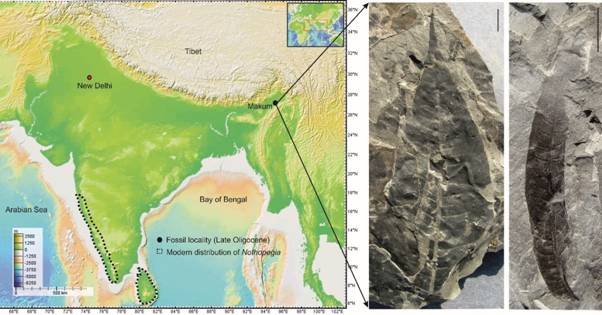Scientists have uncovered a remarkable 24-million-year-old secret hidden in the coal beds of Assam’s Makum Coalfield, shedding new light on South Asia’s ancient biodiversity. Fossilized leaves, identified as the world’s oldest known record of the Nothopegia plant genus, were discovered by researchers from the Birbal Sahni Institute of Palaeosciences (BSIP) in Lucknow, an autonomous institute under the Department of Science and Technology.
The fossil leaves, dating back to the late Oligocene epoch (24–23 million years ago), bear a striking resemblance to the modern Nothopegia species found today in the Western Ghats, a UNESCO World Heritage Site and one of the world’s key biodiversity hotspots, located thousands of kilometers away from Assam. Notably, the Nothopegia genus no longer grows in Northeast India, making this discovery a significant clue to the region’s ecological past.
Using advanced techniques such as herbarium comparison, cluster analysis, and the Climate Leaf Analysis Multivariate Program (CLAMP), the research team reconstructed the ancient environment of Northeast India. Their findings reveal a warm, humid climate during the late Oligocene, similar to the conditions in the Western Ghats today, which once supported Nothopegia’s growth in Assam.
The study, published in the journal *Review of Palaeobotany and Palynology*, traces the dramatic journey of Nothopegia from Northeast India to its current refuge in the Western Ghats. Geological upheavals, including the rise of the Himalayas due to tectonic movements, triggered significant climate changes in the Northeast, altering temperature, rainfall, and wind patterns. These shifts made the region inhospitable for tropical species like Nothopegia, leading to its disappearance from Assam. However, the plant survived in the climatically stable Western Ghats, where it remains a living relic of an ancient ecosystem.
“This fossil discovery is a window into the past that helps us understand the future,” said Dr. Harshita Bhatia, a co-author of the study. By combining paleobotany, systematics, and climate modeling, the research offers insights into how ecosystems adapt to environmental pressures and how some species endure dramatic shifts.
The findings also carry implications for today’s rapidly changing climate. Unlike ancient climate shifts, modern changes driven by human activity are occurring at an unprecedented pace. Understanding Nothopegia’s ancient migration highlights the importance of protecting biodiversity hotspots like the Western Ghats, which serve as sanctuaries for ancient plant lineages. The study underscores the need to preserve these ecosystems to safeguard India’s rich biodiversity amid ongoing climatic challenges.














